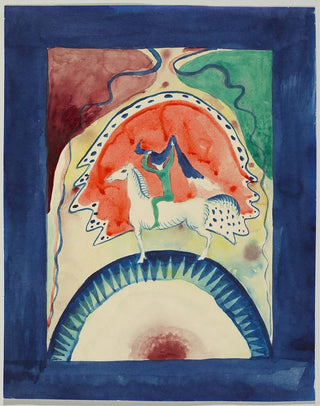Art print | Cover design of the Le Cavalier Bleu almanac - Wassily Kandinsky


View from behind

Frame (optional)
Conception of the cover art print for the Almanach Le Cavalier Bleu - Wassily Kandinsky – Captivating introduction
The art print of the cover of the Almanach Le Cavalier Bleu, an iconic work by Wassily Kandinsky, stands out as a masterpiece of the expressionist movement. This piece, created in 1912, embodies the bold turning point of modern art, where color and form transcend figurative representation to express deep emotions. In an era where art seeks to free itself from academic constraints, Kandinsky, as a pioneer, offers a new vision that still resonates today. This masterpiece, both simple and complex, invites the viewer to immerse themselves in a universe where abstraction becomes language.
Style and uniqueness of the work
The uniqueness of this work lies in the harmony of colors and the dynamics of the shapes that coexist within it. Kandinsky plays with vivid hues, circles, lines, and geometric forms that seem to dance across the surface of the cover. Each element is carefully arranged, creating a delicate balance that draws the eye and stimulates the mind. The use of color is not merely aesthetic; it conveys emotions, evoking a sense of freedom and spirituality. This bold style, characteristic of the artist, breaks with tradition and paves the way for new visual explorations. Thus, the cover of the art print becomes a visual manifesto, an invitation to feel rather than simply observe.
The artist and his influence
Wassily Kandinsky, an emblematic figure of modern art, is often regarded as the father of abstract art. Born in Russia in 1866, he managed to combine his academic training with a unique spiritual sensitivity, influenced by music and philosophy. His work is not limited to a mere aesthetic quest; it reflects a deep reflection on the nature of art and its role in society. By founding the group Le Cavalier Bleu with Franz Marc, he sought to create a space where art could flourish freely, away from established norms. His influence is palpable in the work of many contemporary artists who continue to explore the boundaries of abstraction and personal expression. The

Matte finish

View from behind

Frame (optional)
Conception of the cover art print for the Almanach Le Cavalier Bleu - Wassily Kandinsky – Captivating introduction
The art print of the cover of the Almanach Le Cavalier Bleu, an iconic work by Wassily Kandinsky, stands out as a masterpiece of the expressionist movement. This piece, created in 1912, embodies the bold turning point of modern art, where color and form transcend figurative representation to express deep emotions. In an era where art seeks to free itself from academic constraints, Kandinsky, as a pioneer, offers a new vision that still resonates today. This masterpiece, both simple and complex, invites the viewer to immerse themselves in a universe where abstraction becomes language.
Style and uniqueness of the work
The uniqueness of this work lies in the harmony of colors and the dynamics of the shapes that coexist within it. Kandinsky plays with vivid hues, circles, lines, and geometric forms that seem to dance across the surface of the cover. Each element is carefully arranged, creating a delicate balance that draws the eye and stimulates the mind. The use of color is not merely aesthetic; it conveys emotions, evoking a sense of freedom and spirituality. This bold style, characteristic of the artist, breaks with tradition and paves the way for new visual explorations. Thus, the cover of the art print becomes a visual manifesto, an invitation to feel rather than simply observe.
The artist and his influence
Wassily Kandinsky, an emblematic figure of modern art, is often regarded as the father of abstract art. Born in Russia in 1866, he managed to combine his academic training with a unique spiritual sensitivity, influenced by music and philosophy. His work is not limited to a mere aesthetic quest; it reflects a deep reflection on the nature of art and its role in society. By founding the group Le Cavalier Bleu with Franz Marc, he sought to create a space where art could flourish freely, away from established norms. His influence is palpable in the work of many contemporary artists who continue to explore the boundaries of abstraction and personal expression. The






